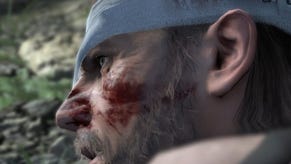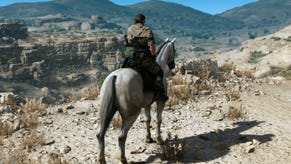Life after Ground Zeroes - what's new with MGS5: The Phantom Pain?
Digital Foundry explores the 30-minute E3 demo.
Earlier this year we were given a taste of Metal Gear Solid 5 with the release of Ground Zeroes across four different console platforms. It was an impressive game with a robust graphics engine, but it only represented a small chunk of what will ultimately become Metal Gear Solid 5: The Phantom Pain, due next year. However, the release of a 1080p60 video of the 30-minute E3 demo (at 50mbps h.264 no less) allows us to post an update to some of the visible changes observed in this demo version of The Phantom Pain versus what we experienced earlier with Ground Zeroes.
First and foremost it should be noted that this demo was played on a PlayStation 4 and, as such, operates with the same 1080p FXAA sampled image quality as the Ground Zeroes sampler you've already played. In short, it still looks great but some areas where the game is a little lacking tend to be much more noticeable in the new locale - for example texture filtering is an area that could do with some improvements. This wasn't a particularly big issue with Ground Zeroes but it is more noticeable in this demo and smears a lot of the game's artwork during gameplay. Many PS4 and Xbox One titles tend to suffer in this regard, and we hope to see some improvement before release.
Looking beyond image quality we found a few other things worth mentioning. The most noticeable change in this most recent demo is the inclusion of a robust motion blur implementation. Motion blur is now appropriately applied to animations and camera movement, further enhancing fluidity of the experience. Interestingly these effects were already present on Xbox One but were missing in the PS4 release of Ground Zeroes. It would appear that The Phantom Pain addresses this by introducing these effects on PS4 as well. It's a nice effect, but there are some artifacts visible at points, for example around the wheels on the jeep as Big Boss drives away from the scene. At 60fps, motion blur is less noticeable than at lower frame-rates but it definitely adds an extra layer of polish to the experience.
Beyond that, we really didn't find any other significant improvements but we did notice some potential issues. The environment in this demo is much larger than anything in Ground Zeroes and was demoed almost entirely during the day. The effect of moving to a larger environment bathed in bright sunlight results in obvious level of detail (LOD) issues and object pop-in that was mostly hidden away in Ground Zeroes. Simply riding across the land reveals shifting and popping rock structures while additional foliage is drawn in at a certain distance threshold. While these issues were not really noticeable in Ground Zeroes on Xbox One or PS4, they were supremely obvious on last generation platforms leaving us to wonder how the final game will fare on those lesser machines.
The demo also finally demonstrates the Fox Engine's dynamic time of day functionality. While Ground Zeroes featured a number of missions taking place at different times of day these changes never occurred in real-time; this new demo introduces a real-time system that can even be accelerated through the psychedelic properties of an e-cigar complete with holographic smoke. While there are some issues with shadows, including obvious dithering and ragged edges visible at a distance, the overall effect of shadows pouring over the landscape is quite impressive. What's particularly interesting here is that time of day actually impacts the locations and patterns of enemies. The demo showcases the sleep and wake cycle of these guards allowing the player to watch enemy patterns before infiltrating the base allowing what might just have been a graphical feature to improve actual gameplay.
The Phantom Pain is not going to redefine visuals for the next-generation but it does return to the type of pristine presentation that has allowed Metal Gear Solid 2 to stand the test of time. Ground Zeroes manages to get by with barely a single dropped frame on PS4 with only very specific moments of burying the camera in the grass causing any dips at all. While The Phantom Pain E3 code still has some performance snafus to address, the demo manages to hold a sustained 60fps for the vast majority of the time, despite the large increase in environment size and complexity. It's not perfect, however, and we observed a number of situations where duplicate frames appear producing very slight dips in performance. Notably this occurs during the sandstorm and in sections taking place within buildings. Keeping in mind that the release date is still some way off, the game is already in fantastic shape.
What's really exciting about Metal Gear Solid 5 thus far is really just how polished it is despite taking place within a much larger world. The development team has managed to retain the level of detail you expect from a more linear experiences and apply it to a massive area. There were certainly concerns that going open world might compromise this aspect of Metal Gear, but that does not seem to be the case at all. The game seems to be taking an approach not unlike the original Crysis but with even more flexibility in the form of a fully dynamic time of day.
All of this is accompanied by excellent cinema production that manages to completely avoid cutting at any point; the camera moves smoothly from cut-scenes to gameplay and back. It's an impressive evolution of Metal Gear's cinematic approach to gaming, and we can't wait to see how it's applied to the completed game.


















